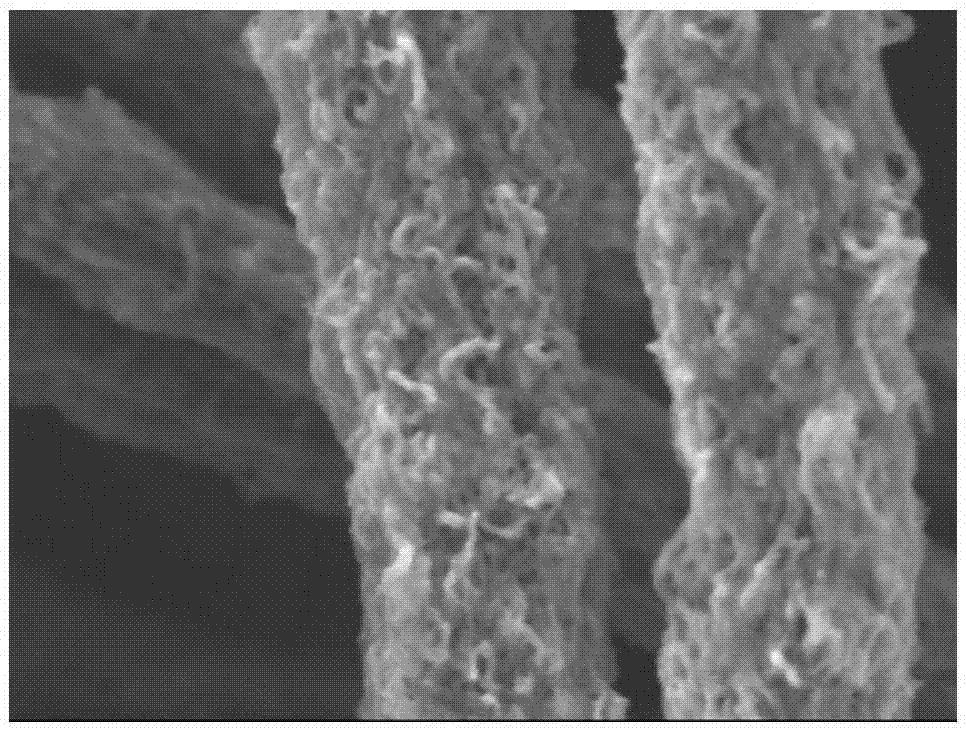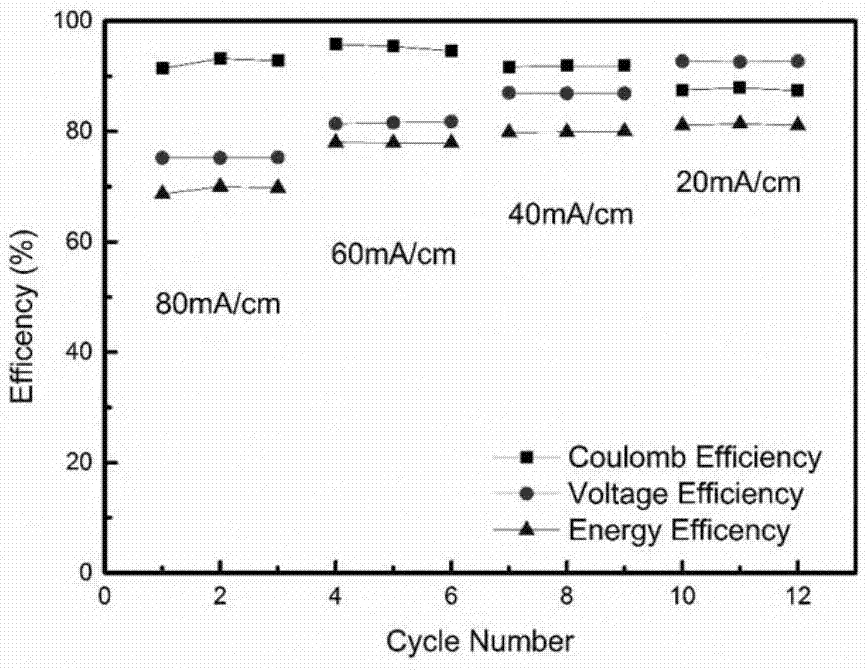Carbon nanotube self-assembly nanofiber felt and preparation and application thereof
A technology of carbon nanotubes and nanofibers, which is applied to carbon nanotube self-assembled nanofiber felt materials and its application in all-vanadium redox flow batteries, can solve problems such as difficult practical applications, and achieve low prices and easy-to-obtain raw materials , to avoid the effect of the use of binder
- Summary
- Abstract
- Description
- Claims
- Application Information
AI Technical Summary
Problems solved by technology
Method used
Image
Examples
Embodiment 1
[0033] Select carbon nanotubes with a diameter of 20nm and a length of 20μm, disperse a certain mass of carbon nanotubes in N,N-dimethylformamide solution, ultrasonicate for 30 minutes, prepare a carbon nanotube dispersion, and disperse a certain mass of polyacrylonitrile The powder was dissolved in the dispersion liquid, wherein the mass fraction of carbon nanotubes was 7.5%, and the mass fraction of polyacrylonitrile was 7.5%, and stirred at 60° C. for 8 hours to fully dissolve to obtain a uniformly dispersed solution. Then 10 mL of the above solution was placed in a syringe, and spinning was carried out under the conditions of 10KV voltage, 25° C., and a relative humidity of 30%, and the distance between the needle tip of the syringe and the receiving plate was 5 cm. The obtained polymer fiber mat was dried at 110° C. for 10 h, and the obtained polymer fiber mat was pre-oxidized in air at 300° C. for 2 h, then sintered at 1000° C. for 1 h in an argon atmosphere, and dried. ...
Embodiment 2
[0035] Select carbon nanotubes with a diameter of 30nm and a length of 15μm, disperse a certain mass of carbon nanotubes in N,N-dimethylformamide solution, and ultrasonicate for 30 minutes to configure a carbon nanotube dispersion, and a certain mass of polymethyl The methyl acrylate powder was dissolved in the dispersion liquid, wherein the mass fraction of carbon nanotubes was 10%, and the mass fraction of polymethyl methacrylate was 5%, and stirred at 50° C. for 24 hours to fully dissolve to obtain a uniformly dispersed solution. Then, 10 mL of the above solution was placed in a syringe, and spinning was carried out under the conditions of 15KV voltage, 25° C., and 10% relative humidity, and the distance between the needle tip of the syringe and the receiving plate was 5 cm. The obtained polymer fiber mat was dried at 110° C. for 10 h, and the obtained polymer fiber mat was pre-oxidized in air at 300° C. for 2 h, then sintered at 1000° C. for 1 h in an argon atmosphere, and ...
Embodiment 3
[0037]Select carbon nanotubes with a diameter of 30nm and a length of 15μm, disperse a certain mass of carbon nanotubes in N,N-dimethylformamide solution, ultrasonicate for 30 minutes, configure a carbon nanotube dispersion, and disperse a certain mass of polylactic acid powder Dissolve in the dispersion liquid, wherein the mass fraction of carbon nanotubes is 5%, and the mass fraction of polylactic acid is 5%, and stirred at 55° C. for 12 hours to fully dissolve to obtain a uniformly dispersed solution. Then 15 mL of the above two solutions were placed in syringes respectively, and spinning was carried out under the conditions of 20KV voltage, 25° C., and relative humidity of 15%, and the distance between the needle tip of the syringe and the receiving plate was 10 cm. The obtained polymer fiber mat was pre-oxidized in air at 300°C for 3h, then sintered at 800°C for 2h under an argon atmosphere, and dried. The diameter of fiber in the gained carbon nanotube fiber felt is abou...
PUM
| Property | Measurement | Unit |
|---|---|---|
| Diameter | aaaaa | aaaaa |
| Diameter | aaaaa | aaaaa |
| Length | aaaaa | aaaaa |
Abstract
Description
Claims
Application Information
 Login to View More
Login to View More - R&D
- Intellectual Property
- Life Sciences
- Materials
- Tech Scout
- Unparalleled Data Quality
- Higher Quality Content
- 60% Fewer Hallucinations
Browse by: Latest US Patents, China's latest patents, Technical Efficacy Thesaurus, Application Domain, Technology Topic, Popular Technical Reports.
© 2025 PatSnap. All rights reserved.Legal|Privacy policy|Modern Slavery Act Transparency Statement|Sitemap|About US| Contact US: help@patsnap.com


